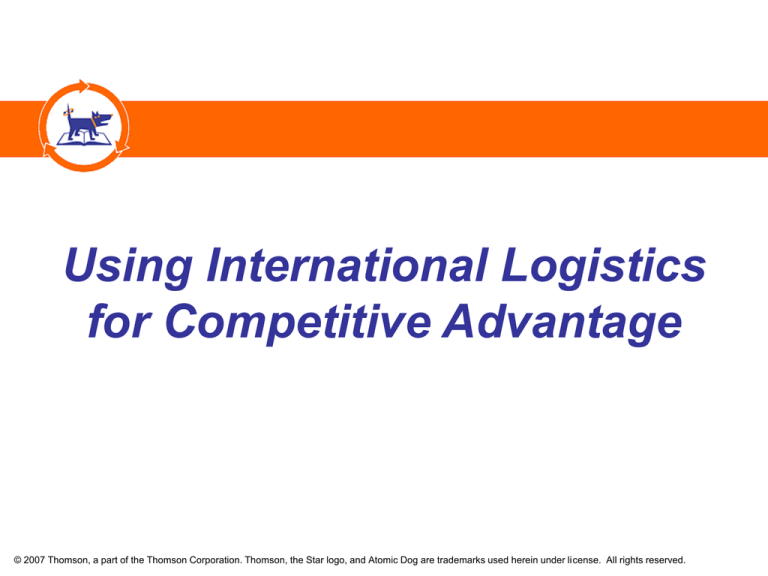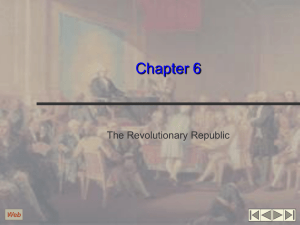
Using International Logistics
for Competitive Advantage
© 2007 Thomson, a part of the Thomson Corporation. Thomson, the Star logo, and Atomic Dog are trademarks used herein under license. All rights reserved.
International Logistics for
Competitive Advantage
Communication Challenges
International English
Special English
Metric System
Cultural Sensitivity
Specific Advice
© 2007 Thomson, a part of the Thomson Corporation. Thomson, the Star logo, and Atomic Dog are trademarks used herein under license. All rights reserved.
International Logistics for
Competitive Advantage
Communication Challenges
International English
Special English
Metric System
Cultural Sensitivity
Specific Advice
© 2007 Thomson, a part of the Thomson Corporation. Thomson, the Star logo, and Atomic Dog are trademarks used herein under license. All rights reserved.
Communication Challenges
• Effective communication is a challenge in international trade.
• Most international communication takes place in English.
• English is everybody’s “second language.”
• Native speakers and non-native speakers have a particularly
hard time communicating.
• Most international communication is done in challenging
conditions: over the phone, by fax or through e-mail.
• Good communications build a competitive advantage.
© 2007 Thomson, a part of the Thomson Corporation. Thomson, the Star logo, and Atomic Dog are trademarks used herein under license. All rights reserved.
Communication Challenges
Category 1: Languages closest to English; easiest to learn
Roman alphabet, similar grammar, similar
syntax
Spanish, French, Dutch, Italian,
Portuguese, Norwegian, Swedish,
German
Category 2: Languages difficult to learn
Roman alphabet, different grammar,
different syntax
Indonesian, Turkish, Icelandic, Czech,
Hungarian, Vietnamese, Polish,
Slovak, Finnish
Category 3: Languages very difficult to learn
Different alphabet, different grammar, very
different syntax
Hebrew, Russian, Greek, Hindi, Thai
Category 4: Languages extremely difficult to learn
Complex alphabet, multiple alphabets or no
alphabet, very different grammar, very
different syntax
Chinese (Cantonese and Mandarin),
Japanese, Korean, Arabic
Classification of Languages in Terms of Difficulty to Learn for a Native
English Speaker
© 2007 Thomson, a part of the Thomson Corporation. Thomson, the Star logo, and Atomic Dog are trademarks used herein under license. All rights reserved.
International Logistics for
Competitive Advantage
Communication Challenges
International English
Special English
Metric System
Cultural Sensitivity
Specific Advice
© 2007 Thomson, a part of the Thomson Corporation. Thomson, the Star logo, and Atomic Dog are trademarks used herein under license. All rights reserved.
International English
Definition
• A technique of written communication in the English language,
developed by Edmond Weiss
• It consists of removing all possible ambiguities, so that the
communication can be understood by someone with a limited
knowledge of English.
• Using International English in written communications can help
build a competitive advantage.
© 2007 Thomson, a part of the Thomson Corporation. Thomson, the Star logo, and Atomic Dog are trademarks used herein under license. All rights reserved.
International English
Rules of Good Written Communication
• Always assume that the person for whom English is a second
language is relying on a dictionary for some words; use the word
with the clearest definition.
Example
• Do not write “The company’s sales took off 25 percent last year,”
as “take off” is likely to be misunderstood.
• Write “The company’s sales increased 25 percent last year.”
• Identify which dictionary definition matches “increase” in the next
slide; what is the first definition? Speculate as to what could be
understood.
© 2007 Thomson, a part of the Thomson Corporation. Thomson, the Star logo, and Atomic Dog are trademarks used herein under license. All rights reserved.
International English
Take-Off entry in the dictionary:
© 2007 Thomson, a part of the Thomson Corporation. Thomson, the Star logo, and Atomic Dog are trademarks used herein under license. All rights reserved.
International English
Rules of Good Written Communication
• Always proofread carefully and avoid all grammatical and
spelling errors.
Example
• Do not write “The customer purchases products from Company A
and it’s marketing services form Company B.”
• Write “The customer purchases products from Company A and
[its] marketing services from Company B.”
• The original sentence could be understood as “The customer
purchases products from Company A and (it is in the business of)
marketing services for Company B.”
© 2007 Thomson, a part of the Thomson Corporation. Thomson, the Star logo, and Atomic Dog are trademarks used herein under license. All rights reserved.
International English
Rules of Good Written Communication
• Always make sure that quantitative information will be
understood without doubt.
Example
• Do not write “The patent was granted on 06/12/05.”
• Write “The patent was granted on 12 June 2005.”
• An American reader will understand the original 06/12/05
“correctly,” but a French reader will understand “6 December
2005” and a Chinese reader will understand “5 December 2006.”
© 2007 Thomson, a part of the Thomson Corporation. Thomson, the Star logo, and Atomic Dog are trademarks used herein under license. All rights reserved.
International English
Rules of Good Written Communication
• Always use simple and short sentences, containing only one
idea, and avoid all stylistic “shortcuts.”
Example
• Do not write “The company requests the report be sent early in
the month.”
• Write “The company requests that the report should be sent
between the first and fifth day of the month,” although it may not
be perfect grammatical English.
© 2007 Thomson, a part of the Thomson Corporation. Thomson, the Star logo, and Atomic Dog are trademarks used herein under license. All rights reserved.
International English
Rules of Good Written Communication
• Never use idioms that are sport or military related, as they are
rarely, if ever, understood properly.
Example
• Do not write “Our salespeople hit several home runs at the trade
show last week.”
• Write “Our salespeople had several substantial successes at the
trade show last week.”
• Consider that a “home run” is a “hit in baseball that enables the
batter to make a complete circuit of the bases and score a run,”
and speculate on what the foreign recipient of this e-mail will
understand
© 2007 Thomson, a part of the Thomson Corporation. Thomson, the Star logo, and Atomic Dog are trademarks used herein under license. All rights reserved.
International Logistics for
Competitive Advantage
Communication Challenges
International English
Special English
Metric System
Cultural Sensitivity
Specific Advice
© 2007 Thomson, a part of the Thomson Corporation. Thomson, the Star logo, and Atomic Dog are trademarks used herein under license. All rights reserved.
Special English
Definition
• A technique of oral communication in the English language,
developed by the Voice of America.
• It is designed so that the oral communication can be understood
by someone with a limited knowledge of English.
• Using Special English in phone conversations and in-person
conversations can help build a competitive advantage.
© 2007 Thomson, a part of the Thomson Corporation. Thomson, the Star logo, and Atomic Dog are trademarks used herein under license. All rights reserved.
Special English
Rules of Special English
• Sentences should be short and contain only one idea.
Example
• Do not say “We did not yet get delivery of this shipment because
our freight forwarder told us that Customs was waiting for a
document that our bank had not released.”
• Say “We did not get delivery of the shipment. There is a problem
with a document. Our bank has not released the document to
Customs. We learned this information from our freight forwarder,”
although the last sentence is probably unnecessary.
© 2007 Thomson, a part of the Thomson Corporation. Thomson, the Star logo, and Atomic Dog are trademarks used herein under license. All rights reserved.
Special English
Rules of Special English
• The vocabulary should be limited to correct and accurate terms.
Example
• Do not say “We will call you tomorrow, irregardless, about the
amount of boxes that we did not receive.”
• Say “We will call you tomorrow about the number of boxes that
we did not receive.” *
* “Amount” is a word used for non-countable items (sand, money, etc.: we cannot say 1 sand, 2
sands, ...) and “number is the correct word for countable items (1 box, 2 boxes, ...).
“Irregardless” is a non-existent word
© 2007 Thomson, a part of the Thomson Corporation. Thomson, the Star logo, and Atomic Dog are trademarks used herein under license. All rights reserved.
Special English
Rules of Special English
• The speed at which the sentences are spoken should be slower.
Example
• Do not speak at a normal conversational rate.
• Speak as slowly as you can possibly handle, enunciate every
word of every sentence and make every word “distinct” from the
others; a good reference would be to think of a teacher dictating
to his/her students, but without the long pauses of a dictation.
© 2007 Thomson, a part of the Thomson Corporation. Thomson, the Star logo, and Atomic Dog are trademarks used herein under license. All rights reserved.
Special English
Rules of Special English
• If a foreigner asks a native speaker to repeat a sentence, do not
repeat it louder.
• The native speaker should repeat the sentence using slightly
different vocabulary or repeat the sentence and offer an
alternative word.
Example
• Suppose “Our company would like to sleep on that proposal for a
few days,” is not understood.
• Repeat “Our company would like to sleep on that proposal –
think about it – for a few days.”
© 2007 Thomson, a part of the Thomson Corporation. Thomson, the Star logo, and Atomic Dog are trademarks used herein under license. All rights reserved.
International Logistics for
Competitive Advantage
Communication Challenges
International English
Special English
Metric System
Cultural Sensitivity
Specific Advice
© 2007 Thomson, a part of the Thomson Corporation. Thomson, the Star logo, and Atomic Dog are trademarks used herein under license. All rights reserved.
Metric System
Definition
• A decimal measuring system developed in the late eighteenth
century
• Since the 1960s, it is officially known as the International System
of Units (abbreviated SI, due to its French name, the Système
International d'Unités).
• It is widely adopted worldwide (the only system of measurement
for many countries), but not commonly used in the United States.
• Using the Metric System in all transactions will build a
competitive advantage over U.S. competitors, but will only close
the competitive disadvantage with other foreign competitors.
© 2007 Thomson, a part of the Thomson Corporation. Thomson, the Star logo, and Atomic Dog are trademarks used herein under license. All rights reserved.
Metric System
Rules for using the Metric System
• It should be the only system used in international transactions.
• Few foreigners understand the intricacies of the U.S. system of
measurements.
Example
• Do not offer to sell items in cartons of 24 retail boxes, each being
8 ounces in size.
• A foreigner looking up “ounces” will find that there are at least
five different types of ounces in the U.S. system, and will not
know which was used.
© 2007 Thomson, a part of the Thomson Corporation. Thomson, the Star logo, and Atomic Dog are trademarks used herein under license. All rights reserved.
Metric System
Rules for using the Metric System
• The simple conversion of U.S. units into metric units is not
appropriate; the translation of a “round” number of U.S. units into
an odd number of metric units is not useful.
• Use “round” numbers of metric units.
Example
• Do not sell items in 3.785-liter containers (1 U.S. gallon).
• Sell items in 1- or 2-liter containers, which is what the foreigner
can understand (and its customers).
© 2007 Thomson, a part of the Thomson Corporation. Thomson, the Star logo, and Atomic Dog are trademarks used herein under license. All rights reserved.
International Logistics for
Competitive Advantage
Communication Challenges
International English
Special English
Metric System
Cultural Sensitivity
Specific Advice
© 2007 Thomson, a part of the Thomson Corporation. Thomson, the Star logo, and Atomic Dog are trademarks used herein under license. All rights reserved.
Cultural Sensitivity
Intercultural Communication Points
• Learn the way people address each other in person, in the mail
or over the telephone and the level of formality that such
interactions necessitate.
• Understand the work culture of a country.
• Recognize that there are culturally determined differences in the
way people respond to requests.
• Learn the ways in which people spend their workday.
© 2007 Thomson, a part of the Thomson Corporation. Thomson, the Star logo, and Atomic Dog are trademarks used herein under license. All rights reserved.
International Logistics for
Competitive Advantage
Communication Challenges
International English
Special English
Metric System
Cultural Sensitivity
Specific Advice
© 2007 Thomson, a part of the Thomson Corporation. Thomson, the Star logo, and Atomic Dog are trademarks used herein under license. All rights reserved.
Specific Advice
• A company can obtain a strategic advantage over its competitors
by making customer-driven decisions:
By being flexible in the choice of Incoterm in a particular transaction
By offering terms of payment that are favorable to the customer,
while protecting itself from the risk of default
By choosing a currency of payment that is convenient to the
importer, while hedging its transaction exposure
By being very careful and diligent in its document preparation
By using appropriate and thoughtful packaging alternatives
© 2007 Thomson, a part of the Thomson Corporation. Thomson, the Star logo, and Atomic Dog are trademarks used herein under license. All rights reserved.









